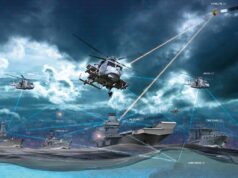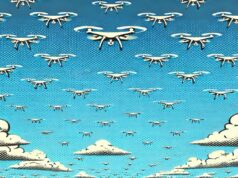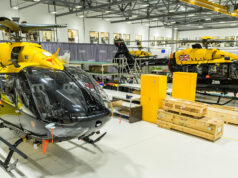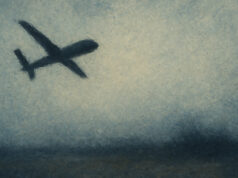BAE Systems has been awarded a six-year contract to deliver support and training to a new joint UK-Qatar Hawk squadron based at RAF Leeming, UK.
BAE Systems say it will provide Qualified Flying Instructors as part of this contract, delivering both live and synthetic training to Qatar Emiri Air Force (QEAF) and Royal Air Force (RAF) pilots.
Noel Henderson, Head of Programme – Qatar Hawk, BAE Systems, said in a news release:
“Working closely alongside the UK Ministry of Defence, we have started to mobilise this service by delivering, installing and commissioning equipment ready for the arrival of the first aircraft. We are proud to support the delivery of training expertise to the new joint squadron and we are recruiting and training personnel through our Qatari joint venture partner company BSL, which recently established a UK entity. These highly-skilled people will work alongside the QEAF and the RAF as part of the Whole Force team.”
“BAE Systems delivers availability support and training to a global fleet of more than 650 Hawk aircraft which forms the heart of the training pipeline of many of the world’s leading air forces. We are a leader in the delivery of effective military training for the world’s air forces and our people continue to work closely alongside our customers to shape the direction of future training.”
The RAF say that the squadron will deliver ‘Advanced Jet Training’ to QEAF and RAF pilots and will be home to Qatar’s recently acquired nine Hawk T2 Mk167 aircraft, built by BAE Systems at Warton, Lancashire.
“The formation of a second UK-Qatar joint squadron will provide additional flying hours for RAF pilots and see long-term international investment in new infrastructure and training facilities at RAF Leeming. This will include a Hawk training simulator, and the refurbishment of existing facilities. The decision to base the new squadron at RAF Leeming represents a long-term commitment to the base, which provides a strategic and operational Main Operating Base for the RAF.”













Isn’t the plan to retire all hawks except from Red Arrow ones by 2025? Unless they buy those American T-7 Red Hawks, I don’t see many advanced trainers able to replace the mighty Hawk
Well most airforces will be looking for new trainers soon. Several NATO countries use the Alpha Jet at moment and that’s been around for a long time.
What’s the plan for training after 2025? With the retiring of the Hawks, a dwindling Typhoon fleet, and insufficient F-35 numbers, the only option seems to be a new aircraft order…
Going to something like 50% synthetic training on simulators, I do believe. Cheaper in the long run and it would seem very very realistic as the modern aircraft you operate (F35) the less you “fly” it, more become a systems operator. I could be talking chuff but that’s the impression I get from a number of sources. Cheers.
its true, virtual simulations are the way forward, cheaper and more efficient
At the end of the day…. You have to actually fly an aircraft. It’s not a video game.
They fly Hawk T2 before heading to F35 or Typhoon OCU’s
4 years to train an RAF pilot, from knowing nothing, to heading to a Typhoon or F35 OCU. They do a lot of flying.
Hawk T2 provides the training. Hawk T1hasn’t been in the traning role for a long time.
2025 Tranche 1/2 Typhoons will be retired due to not being upgradeable, only used for Air Defence and need separate stores as they cannot use the latest versions.
T1s Hawks are only used for basic jet trainers and aggressor duties
F35s numbers are currently greater than pilots trained to fly them.
various new Basic trainers available but only current option built in the UK is the Hawk, which is running down production on the 5 Qatar airframes
Its only the Mk1 and Mk1A retiring. Fast Jet UK training is carried out ay Valley on the T Mk 2
The plan is to replace the veteran RAF Hawk T1 later this decade – but not the glass-cockpit T2 (only acquired by the RAF from 2004 onwards).
When the T1 is replaced, the Red Arrows will probably fly a T2 derived variant – or a new UK jet trainer produced through an international programme, although there is nothing on the horizon, as yet.
The Red Arrows will fly the Hawk T1 until at least 2030
Australia may buy T-7 Red Hawks in 2025-29, so perhaps we could buy their Hawks, which are a heck of a lot newer than RAF T1?
Yes I think that is the T1s, they will still have some T2s but that doesnt solve the problem of what aircraft will replace the Hawks or replace the Red Arrows Hawks .
Aeralis is one possible path –
https://aeralis.com/2021/02/17/aeralis-agrees-3-year-contract-with-rafs-rapid-capabilities-office/
Hawk T2 replaces Hawk T1 in the training role. We haven’t used T1’s for traning for a long time. The Red Arrows will use the T1 until at least 2030.
Give the Red Arrows the Typhoon Tranche 1 aircraft 🙂
RAF chief recently said that they will switch from 70% aircraft 30% simulator training to the other way around. Saves capital and operating costs so hopefully will hear good news from the RAF as we have recently from RN on new capabilities.
When the Hawk was introduced in 1974 it was only 25 years previously since the Spitfire was the prime RAF fighter. It has now been 47 years since the Hawk’s first flight, even Navalships aren’t this old!
Just shows what a superb airframe and engine combination. Nimble, fast, relatively easy to maintain.
Exactly and compared to the longevity of some US aircraft the Hawk is but a pup! I remember when they armed/planned to arm the Hawk with sidewinders to provide point defence at RAF stations. Surely there is a niche for a further development of the Hawk in the air defence role particularly for countries such as ROI or NZ who have no capability in thi arena at present? Alternatively a new multi role trainer/low end basic air defence and attack aircraft?
Indeed. Do recall the Hawk was sold to a number of nations as trainers @ 30 years ago along with strike conversion kits which caused a lot of controversy at the time given potential to be used for supressing insurrection’s…Indonesia was an example. .
It’s been done. Malaysia has the Hawk 208, which is single seat and has a radar directly developed from the one in the F16C.
On paper, very true but Hawk T1s had mainplane (wings) replaced in the early/mid 90s (if memory serves) and a fuselage replacement in late 90s/00s. Other parts were replaced when required/life expired. Very little of a current T1 is “original”.
This aircraft is probably one of the best UK defence export products in recent years. 1,000+ made mostly in UK, it’s been developed into an air-defence fighter (Hawk 200). In fact, its so good that even the US have taken it and made it a carrier-based trainer!
The Hawk has been a fantastic sales success over the years, unfortunately BAE systems sat on their hands and technology moved on.
The Hawk T2 meets the requirements of the RAF, but it’s squeezing the last drops out of a very old airframe design.
BAE should have been beavering away on a new fully digital, composite, modular designed, trainer and light attack design post 2000, they have given away a market sharing lead and dropped out of the market.
It ‘should’ have been BAE systems and SAAB building the Redhawk……
BAE became more interested in building Houses on its old sites rather than its core business.
and there piss contest with UKgovs over MRA4 and Harrier sounded there death bell.
Indeed Johan, One might argue that since its formation in 1999, BAE Systems has never successfully designed an aircraft. Over the last twenty years, it has simply inherited, or bought into, existing programmes.
I agree, BAe always looked to governments to fund the modernisation of the hawk and other platforms, prime example was the advanced hawk, 3 years back BAe wanted 100m to complete the development. They have now be trumped by Boeing and Saab who invested their own cash in the T7 which will dominate the trainer market. Any product should have a % of profits reinvested in RnD for the next generation.
Absolutely, it’s a curious position to be in when they rode high in the market, with 1000 hawks sold….
The Redhawk will gain an unassailable lead in the west, the sheer numbers built will create a very attractive unit and support cost for potential operators.
The Redhawk would be good option for the RAF jet training and also for the Red Arrows replacement.
Hi John, I agree – BAE appears to have thrown away market leadership in advanced training jets.
Apart from the USAF, though, the Boeing Redhawk might prove too expensive to operate as an advanced trainer for most air-forces.
T1s are used as basic jet trainers and aggressor aircraft by the RAF and RN, The MOD looking to outsource the aggressor flights to the private sector companies.
Qatar’s Hawks are the last in the build so these 5 aircraft will last 30 years, there are numerous ALL-NEW jet trainers in production and design.
But none are UK built yet Unless Airbus chucks some work @ a UK Plant to try and swing a UK Sale.
few other options, but the failings of the pilot training program over the past 5 years, has opened avenues for pilot training to be outsourced, with only fast jet being kept in the house, yet most Nato FJ are USA trained.
No doubt we’ll see 100 sqn disband in the future with the aggressor training outscored
Absolutely, outsourcing is the way to go now. To be fair, aircraft like the ex Israeli F16’s make excellent aggressors.
I dare say the Hawk T2’s will go the same way in SDSR 2030, disposed of, with a 100% outsourced training system from day one, until handed over to frontline conversion units.
I doubt very much the T2 will see 40 years of RAF service
On trade-a-plane website are 8x ex Jordanian/UAE updated MK63 Hawks. If anyone in MoD/Whitehall was awake/at their desks, it would be a chance to get a few early 1990s Hawks to replace some 1970s Hawks
The advert has moved to globalplanesearch. 8x flyable MK67 with 60% airfame life remaining for $2 million + $500k for spares package. MK investments in Utah.
I think we have retired the T1s. Could they be renovated in a ground attack role for Nigeria?
https://www.thetimes.co.uk/article/nigerian-bandits-shoot-down-air-force-plane-but-pilot-bails-out-unhurt-bnztbk8m8
On trade-a-plane, Nigeria is selling its Jaguars.
Well there you go. I would think something like Hawk 100 would be the way to go for Nigeria.
14 Jaguars of which, 3 are 2 seaters.